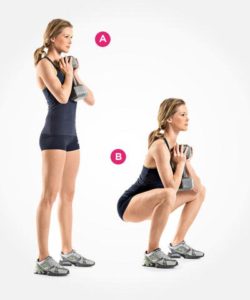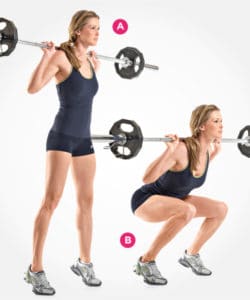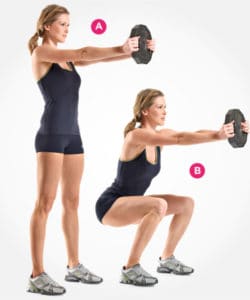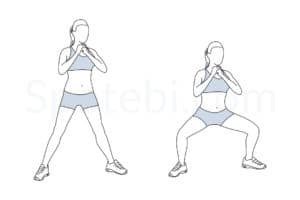During this last month, I have been participating in a squat challenge – 1,000 squats during the month! With a 31 day month, that was an average of 32 squats per day, which seemed pretty doable. With 8 days left in the month, I still have 400 squats to complete. So, instead of actually working on my squats, I’m going to recap the benefits of performing squats and some different varieties you can add to your exercise regime.
Proper Squat Form
But first, let’s talk about what a squat is and how to perform a proper squat. The movement begins from a standing position. The movement is initiated by moving the hips back and bending the knees and hips to lower the torso, then returning to the upright position. Make sure to keep your chest up and don’t let your knees extend beyond your toes.
Benefits
Adapted from Joseph Mercola’s Fitness Panel, here are the top 8 benefits of performing squats:
- Builds Muscle in Your Entire Body
Squats obviously help to build your leg muscles (including your quadriceps, hamstrings, and calves), but they also create an anabolic environment, which promotes body-wide muscle building.
In fact, when done properly, squats are so intense that they trigger the release of testosterone and human growth hormone in your body, which are vital for muscle growth and will also help to improve muscle mass when you train other areas of your body aside from your legs.
So squats can actually help you improve both your upper and lower body strength.
2. Functional Exercise Makes Real-life Activities Easier
Functional exercises are those that help your body to perform real-life activities, as opposed to simply being able to operate pieces of gym equipment. Squats are one of the best functional exercises out there, as humans have been squatting since the hunter-gatherer days. When you perform squats, you build muscle and help your muscles work more efficiently, as well as promote mobility and balance. All of these benefits translate into your body moving more efficiently in the real world too.
3. Burn More Fat
One of the most time-efficient ways to burn more calories is actually to gain more muscle! For every pound of additional muscle you gain, your body will burn an additional 50-70 calories per day. So, if you gain 10 pounds of muscle, you will automatically burn 500-700 more calories per day than you did before.
4. Maintain Mobility and Balance
Strong legs are crucial for staying mobile as you get older, and squats are phenomenal for increasing leg strength. They also work out your core, stabilizing muscles, which will help you to maintain balance, while also improving the communication between your brain and your muscle groups, which helps prevent falls – which is incidentally the #1 way to prevent bone fractures versus consuming mega-dose calcium supplements.
5. Prevent Injuries
Most athletic injuries involve weak stabilizer muscles, ligaments and connective tissues, which squats help strengthen. They also help prevent injury by improving your flexibility (squats improve the range of motion in your ankles and hips) and balance, as noted above.
6. Boost Your Sports Performance – Jump Higher and Run Faster
Whether you’re a weekend warrior or a mom who chases after a toddler, you’ll be interested to know that studies have linked squatting strength with athletic ability. Specifically, squatting helped athletes run faster and jump higher, which is why this exercise is part of virtually every professional athlete’s training program.
7. Tone Your Backside, Abs and Entire Body
Few exercises work as many muscles as the squat, so it’s an excellent multi-purpose activity useful for toning and tightening your behind, abs, and, of course, your legs. Furthermore, squats build your muscles, and these muscles participate in the regulation of glucose and lipid metabolism and insulin sensitivity, helping to protect you against obesity, diabetes and cardiovascular disease.
8. Help With Waste Removal
Squats improve the pumping of body fluids, aiding in removal of waste and delivery of nutrition to all tissues, including organs and glands. They’re also useful for improved movement of feces through your colon and more regular bowel movements.
Squat Varieties

First up, the traditional bodyweight squat. Keep your legs about hip width apart, push your hips back while bending your knees. Bend your knees to about a 90 degree angle and return to an upright position.

The dumbbell squat is just like the bodyweight squat with additional weight. Hold a dumbbell tight to your chest and don’t let it pull your chest forward as you squat down.

Similar to the dumbbell squat, is the kettle bell (or goblet) squat. And I’ll say it again, keep your chest high as you squat. Keep from arching your back.

Another option is to squat with a weight bar.

Another variation is holding a weight (could be a dumbbell too) straight in front of you. This will really challenge your balance, so keep your core tight to avoid leaning into the weight or letting it droop.

The next variation is the wide leg squat that will focus on your inner thighs. These can be done with or without added weights.
Conclusion
What is your favorite squat variety or workout? Please share in the comments!




